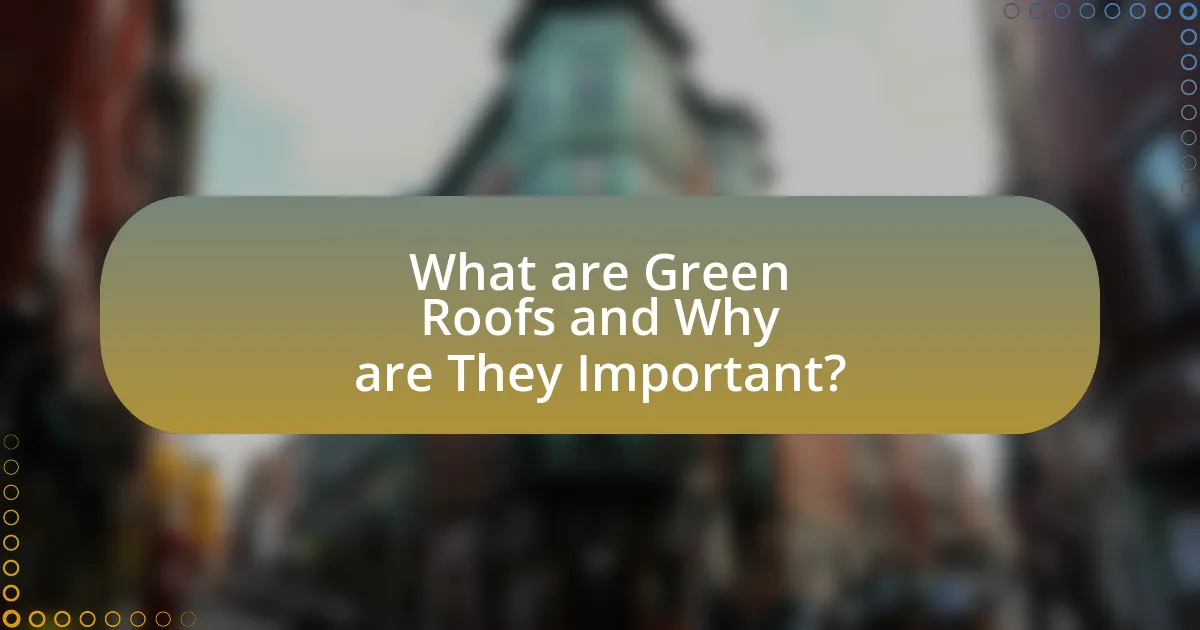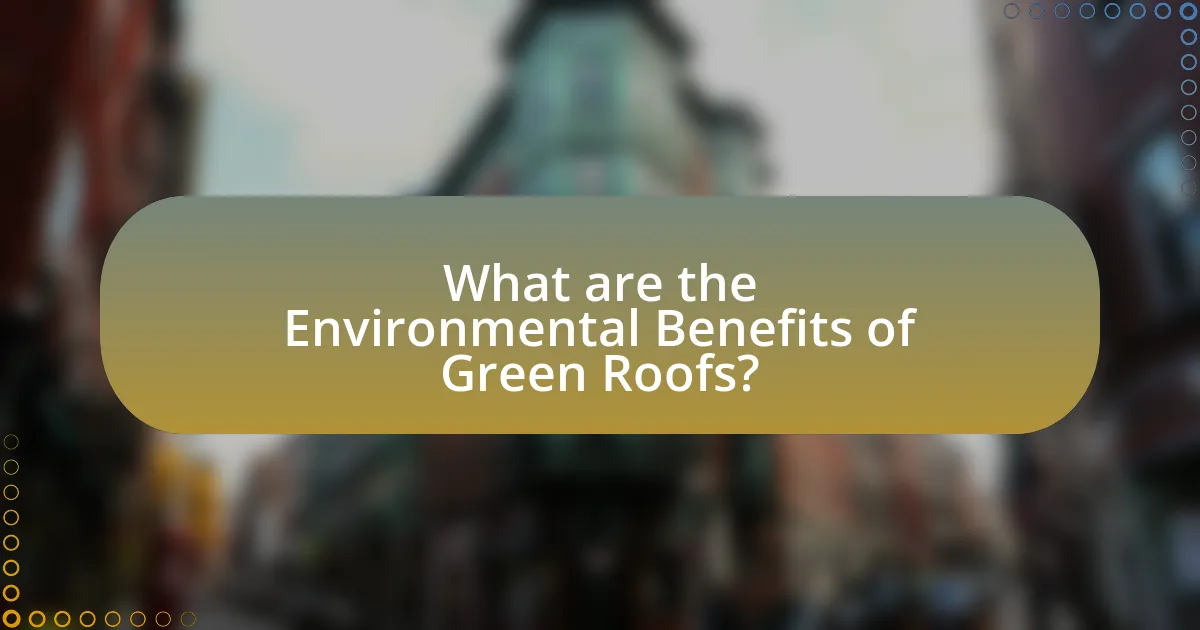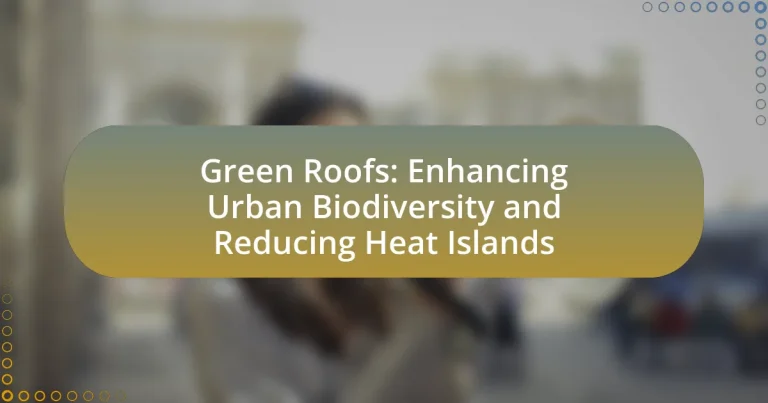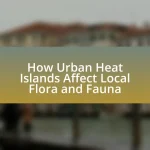Green roofs are vegetated systems installed on building rooftops that provide significant environmental benefits, including enhanced urban biodiversity, reduced urban heat island effects, and improved stormwater management. They create habitats for various species, support local wildlife, and can lower surface temperatures by up to 40% compared to conventional roofs. Additionally, green roofs improve air quality by filtering pollutants and sequestering carbon dioxide, while also managing stormwater runoff effectively. The article explores the types of plants used in green roofs, their role in urban ecosystems, the challenges of implementation, and best practices for design and maintenance, highlighting their importance in promoting sustainable urban environments.

What are Green Roofs and Why are They Important?
Green roofs are vegetated systems installed on building rooftops that provide numerous environmental benefits. They are important because they enhance urban biodiversity by creating habitats for various species, reduce the urban heat island effect by lowering surrounding temperatures, and improve stormwater management by absorbing rainwater. Studies indicate that green roofs can reduce surface temperatures by up to 40% compared to conventional roofs, contributing to energy savings and improved air quality.
How do Green Roofs contribute to urban biodiversity?
Green roofs contribute to urban biodiversity by providing habitats for various plant and animal species in densely populated areas. These green spaces create microhabitats that support pollinators, birds, and other wildlife, which are often scarce in urban environments. Research indicates that green roofs can host a diverse range of flora, with studies showing that they can support up to 150 different plant species, thereby enhancing local biodiversity. Additionally, green roofs help mitigate the urban heat island effect, creating cooler microclimates that further support diverse ecosystems.
What types of plants are typically used in Green Roofs?
Succulent plants, sedums, and native grasses are typically used in green roofs. These plants are chosen for their drought resistance, low maintenance requirements, and ability to thrive in shallow soil conditions. Research indicates that sedums, such as Sedum album and Sedum spurium, are particularly effective in green roofs due to their capacity to store water and withstand extreme temperatures, making them ideal for urban environments.
How do Green Roofs support local wildlife?
Green roofs support local wildlife by providing essential habitats and food sources for various species. These green spaces create microhabitats that attract pollinators, such as bees and butterflies, as well as birds and small mammals. Research indicates that green roofs can increase biodiversity in urban areas by offering native plant species that are crucial for local ecosystems. For instance, a study published in the journal “Ecological Engineering” found that green roofs can host a diverse range of flora and fauna, contributing to the overall health of urban biodiversity.
What role do Green Roofs play in reducing urban heat islands?
Green roofs play a significant role in reducing urban heat islands by providing insulation and increasing vegetation cover in urban areas. The vegetation on green roofs absorbs sunlight and reduces surface temperatures, which can lower ambient air temperatures in surrounding areas. Studies have shown that green roofs can reduce rooftop temperatures by up to 40% compared to conventional roofs, thereby mitigating the heat island effect. Additionally, the evapotranspiration process from plants on green roofs contributes to cooling, further enhancing their effectiveness in urban heat reduction.
How do Green Roofs affect temperature regulation in cities?
Green roofs significantly enhance temperature regulation in cities by providing insulation and reducing heat absorption. These roofs mitigate the urban heat island effect, which occurs when urban areas experience higher temperatures than their rural surroundings due to human activities and infrastructure. Studies indicate that green roofs can lower surface temperatures by up to 40% compared to conventional roofs, as vegetation absorbs sunlight and provides shade. Additionally, the evapotranspiration process from plants on green roofs contributes to cooling, further stabilizing urban temperatures. This dual mechanism of insulation and cooling demonstrates the effectiveness of green roofs in managing urban heat and promoting a more sustainable urban environment.
What are the mechanisms behind heat absorption and insulation in Green Roofs?
Green roofs utilize multiple mechanisms for heat absorption and insulation, primarily through their vegetation, substrate, and design. The vegetation layer absorbs sunlight and converts it into energy through photosynthesis, while also providing shade to the underlying layers. The substrate, typically composed of lightweight soil and organic materials, acts as an insulating barrier, reducing heat transfer to the building below. Additionally, the presence of moisture in the soil and plant materials enhances evaporative cooling, further mitigating heat absorption. Studies indicate that green roofs can reduce rooftop temperatures by up to 40% compared to conventional roofs, demonstrating their effectiveness in heat management.

What are the Environmental Benefits of Green Roofs?
Green roofs provide significant environmental benefits, including improved air quality, reduced urban heat island effect, and enhanced biodiversity. They filter pollutants and carbon dioxide from the air, contributing to cleaner urban environments. Studies show that green roofs can lower surface temperatures by up to 40% compared to conventional roofs, mitigating the urban heat island effect. Additionally, they create habitats for various species, promoting urban biodiversity; research indicates that green roofs can support up to 30 different plant species and attract pollinators like bees and butterflies.
How do Green Roofs improve air quality?
Green roofs improve air quality by filtering pollutants and absorbing carbon dioxide. The vegetation on green roofs captures particulate matter and other airborne toxins, effectively reducing the concentration of harmful substances in the atmosphere. Studies indicate that green roofs can remove up to 60% of particulate matter from the air, contributing to cleaner urban environments. Additionally, the plants release oxygen through photosynthesis, further enhancing air quality.
What pollutants can Green Roofs help mitigate?
Green roofs can help mitigate air pollutants such as particulate matter (PM), nitrogen dioxide (NO2), and carbon dioxide (CO2). Studies have shown that vegetation on green roofs captures particulate matter, reducing its concentration in the air. Additionally, plants absorb nitrogen dioxide and carbon dioxide, contributing to improved air quality. Research indicates that green roofs can reduce PM levels by up to 60% and NO2 levels by approximately 30%, demonstrating their effectiveness in urban environments.
How do Green Roofs contribute to carbon sequestration?
Green roofs contribute to carbon sequestration by absorbing carbon dioxide through photosynthesis in the vegetation they support. The plants on green roofs capture atmospheric CO2, which is then stored in their biomass and the soil beneath. Studies indicate that green roofs can sequester approximately 1.1 to 2.5 kg of CO2 per square meter annually, depending on the plant species and local climate conditions. This process not only reduces greenhouse gases in the atmosphere but also enhances urban biodiversity and mitigates heat island effects, further supporting environmental sustainability.
What are the water management benefits of Green Roofs?
Green roofs provide significant water management benefits by reducing stormwater runoff and improving water retention. They can absorb and store rainwater, which mitigates flooding and decreases the burden on urban drainage systems. Studies indicate that green roofs can retain up to 75% of rainfall during peak events, effectively delaying runoff and allowing for gradual release into the drainage system. This capability not only helps manage excess water but also enhances the overall resilience of urban environments against extreme weather events.
How do Green Roofs reduce stormwater runoff?
Green roofs reduce stormwater runoff by absorbing and retaining rainwater through their vegetation and substrate layers. The plants and soil on green roofs capture precipitation, which decreases the volume of water that flows into drainage systems. Studies indicate that green roofs can retain up to 75% of rainfall, significantly mitigating the impact of stormwater runoff on urban infrastructure. This retention not only reduces flooding risks but also improves water quality by filtering pollutants before they reach storm drains.
What is the impact of Green Roofs on urban flooding?
Green roofs significantly reduce urban flooding by absorbing rainwater and decreasing runoff. They can retain up to 75% of precipitation, which mitigates the volume of water entering drainage systems during heavy rainfall. Studies indicate that green roofs can delay peak runoff times by up to 30 minutes, allowing for better management of stormwater. This capacity to manage water effectively helps prevent urban flooding, particularly in densely populated areas where impervious surfaces dominate.

What are the Challenges and Considerations for Implementing Green Roofs?
The challenges and considerations for implementing green roofs include structural load capacity, maintenance requirements, and initial costs. Structural load capacity is critical, as green roofs add significant weight to buildings, necessitating engineering assessments to ensure safety and compliance with building codes. Maintenance requirements involve regular care, such as irrigation, weeding, and plant health monitoring, which can be resource-intensive. Initial costs can be high, with installation expenses ranging from $10 to $25 per square foot, depending on the complexity and materials used. These factors must be carefully evaluated to ensure the successful integration of green roofs into urban environments.
What are the common barriers to installing Green Roofs?
The common barriers to installing green roofs include high initial costs, structural limitations, and lack of awareness or expertise. High initial costs can deter property owners, as the installation of green roofs typically requires significant investment compared to traditional roofing systems. Structural limitations arise when existing buildings are not designed to support the additional weight of soil and vegetation, necessitating costly reinforcements. Additionally, a lack of awareness or expertise among architects, builders, and property owners can lead to misconceptions about the feasibility and benefits of green roofs, further hindering their adoption.
How do costs affect the adoption of Green Roof technology?
Costs significantly influence the adoption of Green Roof technology by acting as a primary barrier for many potential users. High initial installation costs, which can range from $10 to $25 per square foot, deter property owners and developers from investing in this sustainable solution. Additionally, ongoing maintenance costs, estimated at 10-20% of the initial investment annually, further complicate financial feasibility. Studies indicate that while Green Roofs can lead to long-term savings through energy efficiency and stormwater management, the upfront financial burden remains a critical factor in decision-making.
What maintenance requirements do Green Roofs entail?
Green roofs require regular maintenance to ensure their health and functionality. This maintenance includes tasks such as irrigation, weeding, fertilization, and monitoring plant health. Specifically, green roofs need to be watered during dry spells to prevent plant stress, and weeds must be removed to avoid competition for resources. Additionally, fertilization may be necessary to replenish nutrients in the growing medium, especially in extensive green roofs where plant growth is limited. Regular inspections are also essential to identify any drainage issues or plant diseases early, ensuring the longevity and effectiveness of the green roof system.
How can communities effectively promote Green Roof initiatives?
Communities can effectively promote Green Roof initiatives by implementing educational programs and providing financial incentives. Educational programs raise awareness about the environmental benefits of green roofs, such as improved air quality and reduced urban heat islands, which can be supported by studies showing that green roofs can lower rooftop temperatures by up to 40%. Financial incentives, such as grants or tax rebates, encourage property owners to invest in green roofs, as evidenced by cities like Toronto, which has seen a significant increase in green roof installations due to its financial support programs. Additionally, forming partnerships with local organizations can enhance outreach and engagement, further driving community interest and participation in green roof projects.
What policies can support the development of Green Roofs?
Policies that can support the development of green roofs include financial incentives, regulatory frameworks, and educational programs. Financial incentives, such as tax credits or grants, encourage property owners to invest in green roofs by reducing upfront costs. Regulatory frameworks, including zoning laws and building codes that mandate or incentivize green roof installations, can facilitate widespread adoption. Educational programs raise awareness about the benefits of green roofs, such as improved urban biodiversity and reduced heat island effects, thereby fostering community support and participation. These policies collectively create an environment conducive to the growth of green roofs in urban areas.
How can public awareness be raised about the benefits of Green Roofs?
Public awareness about the benefits of Green Roofs can be raised through targeted educational campaigns and community engagement initiatives. These campaigns can utilize social media platforms, workshops, and informational seminars to disseminate knowledge about how Green Roofs enhance urban biodiversity and mitigate heat islands. For instance, studies show that Green Roofs can reduce urban temperatures by up to 5 degrees Celsius, which directly addresses the heat island effect. Additionally, partnerships with local governments and environmental organizations can facilitate outreach programs that highlight the ecological and economic advantages of Green Roofs, such as improved air quality and energy savings.
What are best practices for designing and maintaining Green Roofs?
Best practices for designing and maintaining green roofs include selecting appropriate plant species, ensuring proper drainage, and implementing regular maintenance routines. Choosing native and drought-resistant plants enhances biodiversity and reduces water usage, while a well-designed drainage system prevents water accumulation and root rot. Regular maintenance, including weeding, irrigation, and fertilization, is essential to sustain plant health and performance. Studies indicate that green roofs can reduce urban heat islands by up to 5 degrees Celsius, demonstrating their effectiveness in urban environments.


